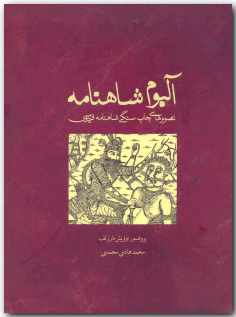Ulrich Marzolph
Exploring the Narrative Culture of the Muslim World

Âlbum-e Shâhnâme: tasvirhâ-ye châp-e sangi-ye Shâhnâme-ye Ferdousi
Shahnameh's Album: A Compendium of Lithographic Illustrations to Ferdousi's Shahnameh
by Ulrich Marzolph and Mohammad Hâdi Mohammadi
Teheran: Chistâ, 1384/2005. XII, 368 p., 348 illustrations
ISBN 964-7940-04-1, hardbound in book-case; 24,500 Tuman (appr. 23,00 €, 28,00 $)
The first complete edition of the Persian "national epic," Ferdousi's Shâhnâme, in print was prepared by Turner Macan and was published in four volumes in Calcutta in 1829. Though orientalist scholars kept preparing other scholarly editions in subsequent years, the Shâhnâme in India and Iran was mainly published in lithographed editions. In contrast to manuscripts, these editions were fairly accessible in terms of price. In contrast to the scholarly printed editions, they shared the advantage of aesthetically appealing calligraphy supplied with relatively simple, yet charming illustrations. In consequence, the Shâhnâme up to the middle of the twentieth century was published in some thirty different lithographed editions, mostly in Indian cities such as Bombay, Lucknow, and Cawnpore. While the series of lithographed editions began with two Indian editions (of 1262/1846 and 1266/1849), a total of five editions were later prepared in Iran.
The present album presents a complete set of the illustrations from the two early Indian editions together with the illustrations from four out of the five Iranian editions. The only edition excluded from the present survey, due to the strong European influence visible in its illustrations, is the so-called Shâhnâme-ye Bahâdori (1319-22/1901-04). The four Persian editions whose illustrations are included comprise the editions 1265-67/1851-53 (illustrated by Mirzâ ÂĎAli-Qoli Kho'i), 1275/1858 (illustrated by Ostâd Sattâr), 1307/1889 (illustrated by Mostafâ), and 1316/1898 (illustrated by ÂĎAbd al-Hosein and Kerbelâ'i Hasan). The illustrations have been arranged according to the chronology of the scenes depicted. They are introduced by lines of poetry from Ferdousi's work and short prose summaries of the depicted event in the framework of the related story.
An introduction (by Ulrich Marzolph) in English, also given in Persian translation, discusses the background of the Shâhnâme's publication history and supplies a comparative list of the 72 different illustrations in the six Indian and Iranian editions considered. A second introduction (by Mohammad Hâdi Mohammdi) in Persian posits the Shâhnâme in terms of its importance for Iranian history and identity.
The Shâhnâme-album for the first time makes the illustrations of this important work in lithographed edition available to a larger public. Besides addressing anybody who is fascinated by Persian art, it constitutes an important tool for research in Persian art of the Qajar period.